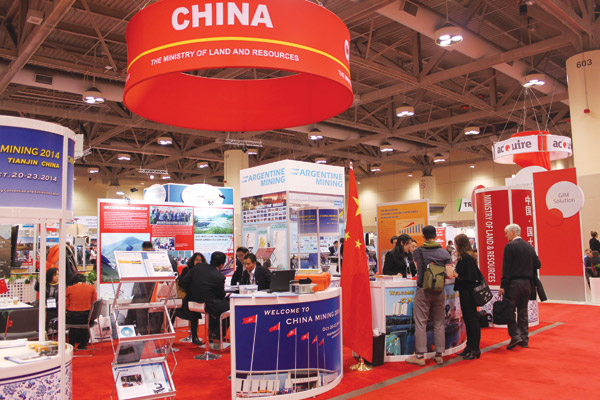Chinese investments with Canadian mining examined
Updated: 2014-03-08 05:48
By LI NA in Toronto (China Daily Canada)
|
||||||||
 |
|
The exhibition booth of the Ministry of Land and Resources of China at the PDAC 2014 in Toronto. Li Na / China Daily |
The growth of investment from China in Canadian industry may not be as strong as in the past few years, but Chinese investment in Canada’s mining sector should pick up momentum in the long run, according to Yu Benlin, minister-counselor for economic and commercial affairs at the Chinese Embassy in Canada.
Yu made the comments at the China Mining Investment Symposium 2014 hosted by the Canada China Chamber of Commerce on March 3 in Toronto. The forum was held during the Prospectors and Developers Association of Canada (PDAC) convention in Toronto, where advisors from government, investors from the mining sector and experts and senior lawyers gathered to exchange views on the challenges and opportunities in the global mining industry, particularly in Canada.
"Although there are many favorable conditions for foreign investors in the mining sector in Canada, Chinese mining companies are facing various challenges and distinctive issues in the Canadian investment environment," Yu noted.
Along with the global mining market’s drop last year, Chinese mining industries showed lackluster performance as well. Investment in China’s mining sector maintained growth but was 7.8 percentage points slower than that of the overall fixed asset investment in the first ten months of 2013. In the first half of 2013, investment in mineral exploration was off 24 percent year-on-year. Stock prices of Chinese mineral companies overall declined.
"The relatively weak performance of mining industries and markets both globally and domestically in turn impacted the enthusiasm of Chinese enterprises to invest overseas," Yu said.
According to the China Mining Association (CMA), Chinese mining companies invested in 103 projects overseas in the first three quarters of 2013, 8 percent fewer than the same period of 2012.
In terms of a business environment, Canada has highly developed science and technology, a robust financial system and easily accessible legal, financial and intermediary services, all of which makes potential investors feel welcome and confident.
However, Yu added, "I heard some Chinese mining companies in Canada complaining that they had invested heavily in infrastructure development, labor and meeting all sorts of standards, while their financial returns have been marginal."
The top consideration for Chinese investors in Canada is certainly the environment for investment. But there may not always be ready infrastructure on the ground, and could possibly be labor shortages, high environmental standards and the challenge of properly managing relations with different social groups, especially the First Nations, Canada’s Aboriginal peoples.
"I advise investors to plan carefully after comprehensively studying these potential concerns and adapt your business well to local conditions," Yu told the gathering.
"We are looking for a resolution in the critical moment of a market downturn and underestimations and will try to seize potential opportunities," said Jin Wenhong, president of Huakan International Mining Inc, a TSX-V exchange-listed company focused on gold and silver.
According to Jin, Huakan has been focusing on high-technology cooperation with the Canadian mining industry to maintain long-term development. "The competition is fierce," he said, "and it’s not only about the money. Actually, the really good enterprises in Canada are never at a lack for investment funding."
"Don’t be anxious to achieve quick success and get instant benefits," Jin said. "As a responsible investor, you need to grow together with the enterprise."
Following Yu, John Gravelle, partner of PricewaterhouseCoopers LLP, said that Chinese investors will continue to dominate the industry’s prospects.
"Although the market has lost confidence in mining industries, I think we see some good signs to start the year off," Gravelle said.
Balance sheets remain healthy and there are lots of opportunities in a mining industry downturn, Gravelle pointed out. "Especially the potential market in China is great," he said. "China will continue to consume nearly 40 percent of the world’s mineral products."
"There’s no doubt that urbanization will be an important driving force in the sustained demand for resources," Gravelle added.
Currently, the urbanization rate in China is at 52.57 percent; the number is expected to reach 60 percent by 2020. That means more than 90 million current rural Chinese residents will become urban residents, which represents a great demographic shift and opportunities.
"China’s economic structure is undergoing a positive change," said Zhong Ziran, chief engineer of the Ministry of Land and Resources of China. "The momentum of growth in energy and mineral demands provides a good opportunity for Chinese and global mining investors."
According to Zhong, further cooperation between the two countries in the mining sector will help China gain a long-term and stable source of supply.
Most Viewed
Editor's Picks

|

|

|

|

|

|
Today's Top News
US puts big 'effort' into China ties
Ford to expand China R&D: report
Chinatown source of infection
HK, NYC magnets for wealthy
Crimea referendum would violate law: Obama
US House passes Ukraine aid bill
DPRK missile 'near misses' airliner
Premier Li puts accent on reform
US Weekly

|

|














